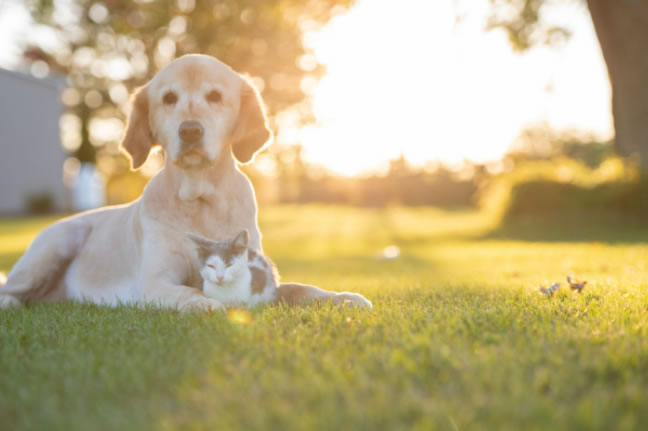As we experience a lift in temperatures and blue skies, we are enjoying more time in the great outdoors, usually with our four-legged family members. During this time, is important to remember how to keep not just ourselves, but our pets safe in the sun.

Sunburn in Pets
If you feel the need to put on sun cream, your dog or cat will definitely need protection too. Just like us, they can get sunburnt on a cloudy day as well.
Areas to watch out for are the tops of ears, nose, paws, or patchy areas (areas with little or no fur). Animals with white/pale fur, patchy fur, or pink skin on their bellies/ears/nose are especially sensitive.
If you wish to, you can apply pet-safe sun cream to your cat or dog. It is more realistic however to offer them plenty of space where there is shade for them to relax.
Walking your dog in the sun or heat
Avoid walking in the middle of the day when the sun is strongest. It is best to have walkies early in the morning or when it is cooler in the evening. Before 8 a.m. or after 5 p.m. is probably ideal.
Pavements can get very hot during the day. Test them with your hand first – if you can’t hold your hand to the pavement for more than 10 seconds, it is too hot for their paws.
If it is a really hot day, make sure you do not over-exercise them causing them to overheat.
Offer shade and hydration to your pets
It is important that your furry friends have access to fresh, cool drinking water throughout the day.
Providing shaded and cool areas is extremely important too. Make sure to not leave your cats and dogs in conservatory areas or other places around your home that easily heat up.
If your animal does need to cool down, you should provide them with cool – not cold – water to help.

Heatstroke in Pets
Heatstroke (or hypothermia) happens when the core body temperature is elevated above the normal range. It is a serious, potentially fatal condition as it can cause our pet’s organs to shut down.
As well as implementing the tips we have above, you can look out for symptoms such as:
- Excessive panting
- Drooling
- Diarrhea or vomiting
- Signs of delirium or dizziness, confusion, and staggering
- Muscle tremors
- Lethargy
To name a few. If you suspect your animal to have heatstroke, you must
- Immediately remove them from the warm area
- Cool them down with tepid – not cold – water
- Apply light fanning
- Take your pet to the nearest vet immediately, this is an emergency
Even if your pet seems to be doing better, you need to take them to the vet for proper care.
You know your four-legged friend better than anyone. Monitor their behavior and any changes they might exhibit during hot and sunny days, and always consult your vet if you are concerned. Enjoy the sun safely!








